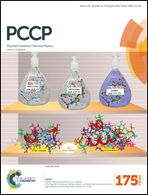Sensitivity enhanced 14N/14N correlations to probe inter-beta-sheet interactions using fast magic angle spinning solid-state NMR in biological solids
Abstract
14N/14N correlations are vital for structural studies of solid samples, especially those in which 15N isotopic enrichment is challenging, time-consuming and expensive. Although 14N nuclei have high isotopic abundance (99.6%), there are inherent difficulties in observing 14N/14N correlations due to limited resolution and sensitivity related to: (i) low 14N gyromagnetic ratio (γ), (ii) large 14N quadrupolar couplings, (iii) integer 14N spin quantum number (I = 1), and (iv) very weak 14N–14N dipolar couplings. Previously, we demonstrated a proton-detected 3D 14N/14N/1H correlation experiment at fast magic angle spinning (MAS) on L-histidine·HCl·H2O utilizing a through-bond (J) and residual dipolar-splitting (RDS) based heteronuclear multiple quantum correlation (J-HMQC) sequence mediated through 1H/1H radio-frequency driven recoupling (RFDR). As an extension of our previous work, in this study we show the utility of dipolar-based HMQC (D-HMQC) in combination with 1H/1H RFDR mixing to obtain sensitivity enhanced 14N/14N correlations in more complex biological solids such as a glycyl-L-alanine (Gly-L-Ala) dipeptide, and parallel (P) and antiparallel (AP) β-strand alanine tripeptides (P-(Ala)3 and AP-(Ala)3, respectively). These systems highlight the mandatory necessity of 3D 14N/14N/1H measurements to get 14N/14N correlations when the amide proton resonances are overlapped. Moreover, the application of long selective 14N pulses, instead of short hard ones, is shown to improve the sensitivity. Globally, we demonstrate that replacing J-scalar with dipolar interaction and hard- with selective-14N pulses allows gaining a factor of ca. 360 in experimental time. On the basis of intermolecular NH/NH distances and 14N quadrupolar tensor orientations, 14N/14N correlations are effectively utilized to make a clear distinction between the parallel and antiparallel arrangements of the β-strands in (Ala)3 through the observation of inter-β-sheet correlations.


 Please wait while we load your content...
Please wait while we load your content...